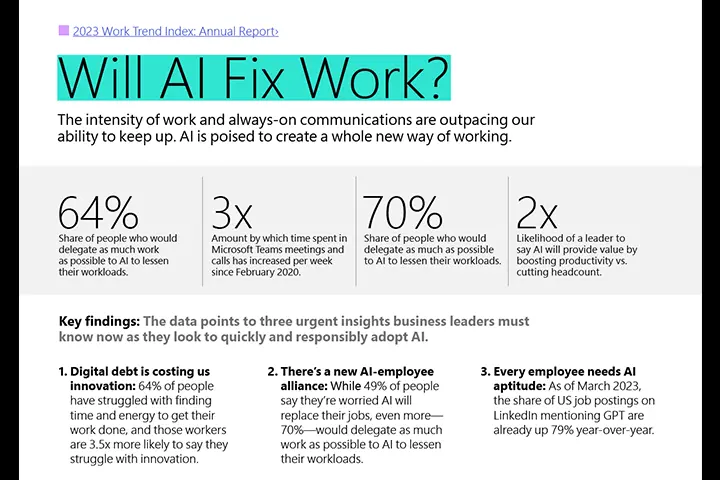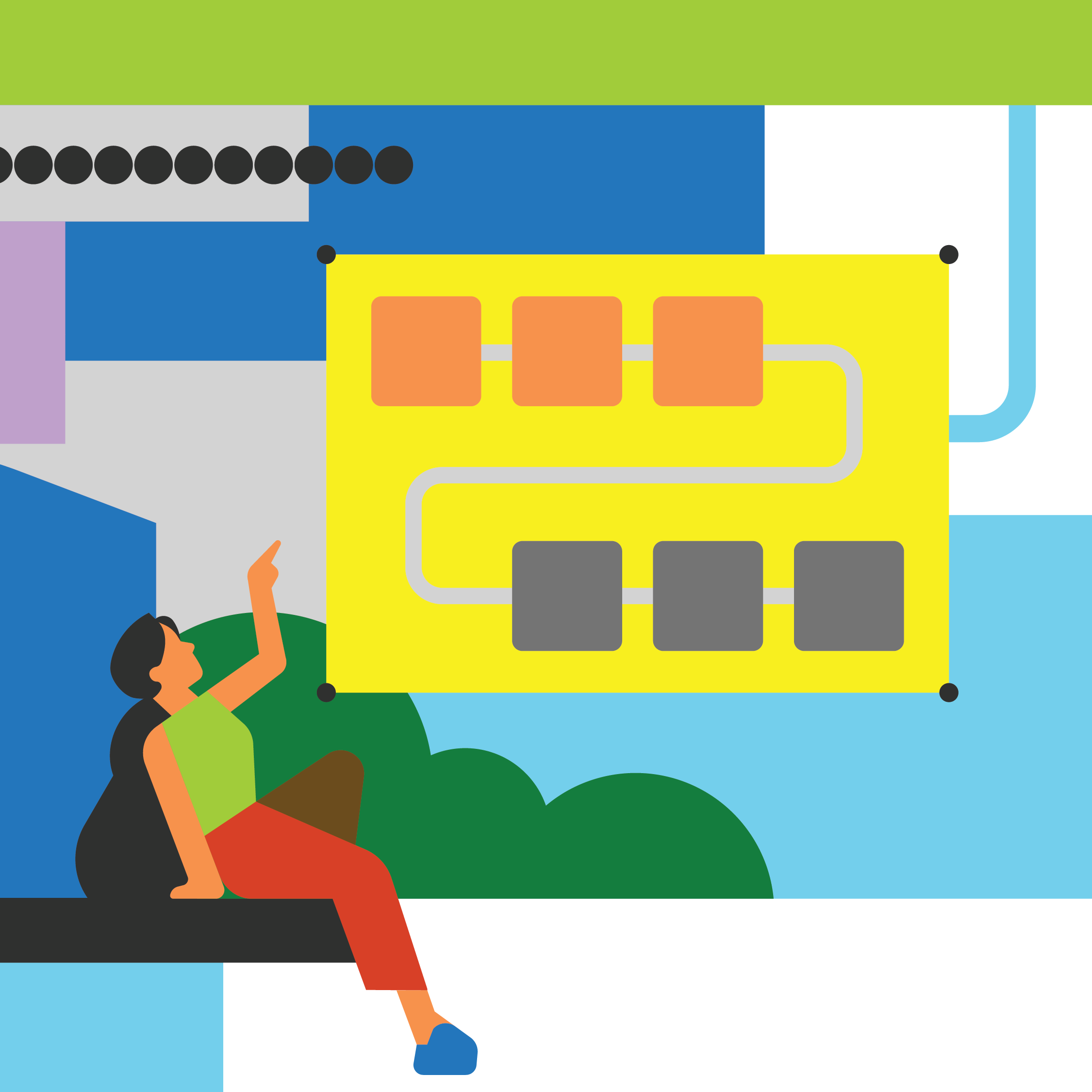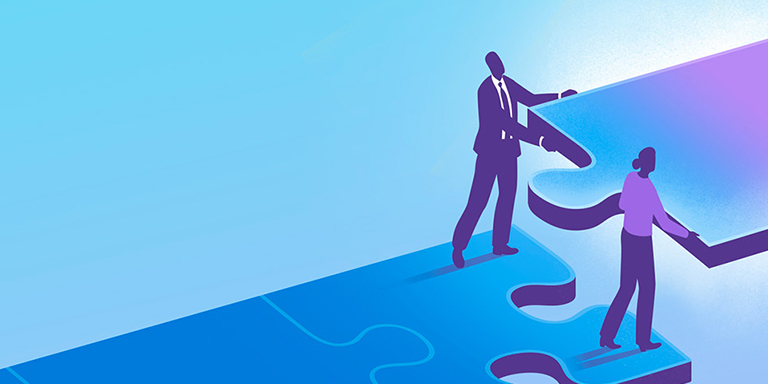The platform shift to AI is underway and will completely transform the way people work. And for many, the fix can't come soon enough. The pace of work has increased exponentially—along with the crush of data, information, and always-on communications. People are struggling to shoulder the weight of it all, while business leaders feel pressure to increase productivity amid economic uncertainty. We spend more and more of our days separating the signal from the noise—at the expense of creativity. And the tax on individual productivity is compounding, undermining organizational productivity and global GDP.
AI can help lift the burden. To date, AI has mostly been on autopilot. Now, next-generation copilots will work alongside people, freeing us from digital debt and fueling innovation. Organizations that embrace AI will unleash creativity and unlock productivity for everyone—ushering in a new wave of productivity growth and value creation.
“This new generation of AI will remove the drudgery of work and unleash creativity,” said Satya Nadella, Chairman and CEO, Microsoft. “There's an enormous opportunity for AI-powered tools to help alleviate digital debt, build AI aptitude, and empower employees.”
To ready leaders and businesses for the age of AI, we surveyed 31,000 people in 31 countries and analyzed trillions of Microsoft 365 productivity signals, along with labor trends from the LinkedIn Economic Graph. The data points to three urgent insights business leaders must know as they look to quickly and responsibly adopt AI .
Download the executive summary

For a PDF for the full report, see below.
1. Digital debt is costing us innovation
We’re all carrying digital debt: the inflow of data, emails, meetings, and notifications has outpaced humans’ ability to process it all. And the pace of work is only intensifying. Everything feels important, so we spend our workdays trying to get out of the red. Nearly 2 in 3 people (64%) say they struggle with having the time and energy to do their job—and those people are 3.5x more likely to also struggle with innovation and strategic thinking. And nearly 2 in 3 leaders (60%) are already feeling the effects, saying that a lack of innovation or breakthrough ideas on their teams is a concern. There are only so many minutes in the day—and every minute we spend managing this digital debt is a minute not spent on the creative work that leads to innovation. In a world where creativity is the new productivity, digital debt is more than an inconvenience—it’s impacting business.
The Weight of the Workday
With the balance of work hours spent communicating, 68% of people say they don’t have enough uninterrupted focus time during the workday.

Illustration by Manuel Bortoletti
68% of people say they don’t have enough uninterrupted focus time during the workday.
Hours worked, workday span, and time spent in meetings have steadily increased over the past few years—it’s easier than ever to communicate and harder than ever to keep up. Taking a closer look at how people spend their time, it’s clear that a lack of focus time, the search for information, and the volume of constant communications have an opportunity cost. Sixty-eight percent of people say they don’t have enough uninterrupted focus time during the workday. And 62% of survey respondents say they struggle with too much time spent searching for information in their workday. Across the Microsoft 365 apps, the average employee spends 57% of their time communicating (in meetings, email, and chat) and 43% creating (in documents, spreadsheets, and presentations). 1 The heaviest email users (top 25%) spend 8.8 hours a week on email, and the heaviest meeting users (top 25%) spend 7.5 hours a week in meetings. 2 And this global average includes frontline workers— for knowledge workers, who rely even more on digital communication, the share of the week taken up by emails and meetings is even greater. AI can tip the balance in people’s favor to reclaim time and energy for the important work that fuels innovation.
Top 5 Obstacles to Productivity
The data reveals an urgent need to make meetings more effective—people report ‘inefficient meetings’ as their number one productivity disruptor.

Survey question: In your current day-to-day role, please rank the following based on how disruptive they are to your productivity.
Illustration by Manuel Bortoletti
Take meetings, for example. People report that the number one productivity disruptor is inefficient meetings, followed closely by having too many meetings at number three. Most people say it’s difficult to brainstorm in a virtual meeting (58%) or catch up if they joined a meeting late (57%), that next steps at the end of a meeting are unclear (55%), and that it’s hard to summarize what happens (56%). And since February 2020, people are in 3x more Teams meetings and calls per week (192%).
The data shows a clear need to make meetings better. Today, only 1 in 3 people (35%) think they would be missed in the majority of their meetings. But meeting FOMO is real. Asked what makes meetings worthwhile, people’s top motivation was, “I will receive information that will help me do my job better”—ahead of giving feedback, making decisions, or advancing their career. With AI, every meeting becomes a digital artifact. When meetings are more than a point in time, you can engage and interact with them when and how it works best for you, whether synchronously or asynchronously.
Take action:
Identify and address your organization’s productivity disruptors with insights from employee listening.
Radically rethink the workday . As AI frees up time and energy, protect focus time for the creative work that leads to innovation.
Think of meetings as a digital artifact and not just a point in time. Encourage people to leverage AI-powered intelligent meeting recaps, transcripts, and recordings to engage with meetings how and when it works best for them.
2. There’s a new AI-employee alliance
Amid concerns of AI replacing jobs, the data revealed an unexpected insight: employees are more eager for AI to lift the weight of work than they are afraid of job loss to AI. While 49% of people say they’re worried AI will replace their jobs, even more—70%—would delegate as much work as possible to AI to lessen their workloads.
“It’s fascinating that people are more excited about AI rescuing them from burnout than they are worried about it eliminating their jobs,” said author and organizational psychology professor Adam Grant. And it turns out people are looking for AI to help in almost every aspect of their work. Not only did 3 in 4 people tell us they would be comfortable using AI for administrative tasks (76%), but most people also said they would be comfortable using it for analytical (79%) and even creative work (73%). People are also looking for AI to assist with finding the right information and answers they need (86%), summarizing their meetings and action items (80%), and planning their day (77%).
“It’s fascinating that people are more excited about AI rescuing them from burnout than they are worried about it eliminating their jobs.”
And the AI optimism doesn’t stop there. People also believe it can enhance creativity, from formulating ideas for their work (76%) to editing their work (75%). The more people understand AI, the more they see its promise to help with the most meaningful parts of their jobs. For example, 87% of workers in creative roles 3 who are extremely familiar with AI said they’d be comfortable using AI for creative aspects of their job.
AI’s Productivity Promise
Amid fears of AI job loss, business leaders are 2x more likely to choose ‘increasing employee productivity’ than ‘reducing headcount’ when asked what they would most value about AI in the workplace.

Survey question: If the growth of artificial intelligence (AI) in the workplace could lead to the following benefits, which would add the most value to your workplace?
Illustration by Manuel Bortoletti
The data shows that business leaders are looking to empower people with AI rather than replace them—they’re 2x more interested in using AI to increase productivity than to cut headcount. In fact, reducing headcount was last on the list of what leaders would value from AI. After “increasing productivity,” leaders’ top hopes for AI are to: help employees with necessary but repetitive tasks, increase employee wellbeing, eliminate employee time spent on low-value activities, enhance employees’ capabilities, and accelerate employees’ pace of work.
Work in 2030: What People Want—That AI Can Deliver
Asked to imagine work in 2030, people we surveyed say they’d most value changes that saved them time—like producing high-quality work and learning new skills faster.

Survey question: Imagine how work could change by 2030. If you could make any of the following changes to your work experience, without any additional effort required on your part, which would you most value?
Illustration by Manuel Bortoletti
We also asked employees and managers to envision how work could change by 2030. Their answers paint a bright future—fueled by AI. When asked what changes they value most, people imagined producing high-quality work in half the time (33%), being able to understand the most valuable ways to spend their time (26%) and energy (25%), and never having to mentally absorb unnecessary or irrelevant information again (23%). And with AI poised to remake work, the future will arrive in months not years.
Take action:
Bring leaders together across the organization to create guardrails that help people experiment safely and responsibly with AI.
Be intentional and programmatic. Like any platform shift, adopting AI at scale requires change management. Pick specific disciplines, processes, and workflows to test and learn, and identify evangelists to lead the charge.
As you begin to adopt AI, deploy it where people need the most relief based on your organization’s pain points and challenges.
3. Every employee needs AI aptitude
The paradigm shift to AI as copilot requires a whole new way of working— and a new AI aptitude. Working alongside AI—using natural language—will be as inherent to how we work as the internet and the PC. Skills like critical thinking and analytical judgment, complex problem solving, and creativity and originality are new core competencies—and not just for technical roles or AI experts. Leaders we surveyed said it’s essential that employees learn when to leverage AI, how to write great prompts, how to evaluate creative work, and how to check for bias. As AI reshapes work, human-AI collaboration will be the next transformational work pattern—and the ability to work iteratively with AI will be a key skill for every employee.
New Skills for a New Way of Working
‘Analytical judgment,’ ‘flexibility,’ and ‘emotional intelligence’ top the list of skills leaders believe will be essential for employees in an AI-powered future.








Illustration by Manuel Bortoletti
Learning isn’t keeping up with the pace of work. Already, 60% of people say they don’t currently have the right capabilities to get their work done. AI will open new paths for learning, and success depends on leaders equipping employees for an AI-powered future.
82% of leaders say their employees will need new skills to be prepared for the growth of AI.
And they’ll need to start building those new skills today: there are 33x as many LinkedIn posts mentioning topics like generative AI and GPT than there were one year ago. “We’re in the next phase of change with the introduction of generative AI, and it’s already starting to reshape the labor market,” said Karin Kimbrough, chief economist at LinkedIn. “While it’s still early days, this shift will expand opportunities, create new roles, and augment productivity.” In fact, as of March 2023, the share of US job postings on LinkedIn mentioning GPT are already up 79% year-over-year. And 82% of leaders in our survey say their employees will need new skills to be prepared for the growth of AI.
Take action:
Help people embrace a new way of working, starting with building AI aptitude —from practicing prompt engineering to fact-checking and verifying AI-generated content.
Leverage learning resources and crowdsource best practices from employees as they adapt to AI as copilot.
Consider how roles and functions can evolve alongside AI, creating opportunities for reinvention.
The Path Forward
AI is poised to lift the weight of work— and has great potential to free people from digital debt and fuel innovation. And for both overwhelmed employees and leaders looking to bolster productivity, that promise is overdue. But AI won’t simply “fix” work—it will create a whole new way of working. Leaders will need to help employees learn to work responsibly alongside AI to reap the rewards of the AI-employee alliance: more value creation for businesses and a brighter, more fulfilling future of work for everyone.
Learn more about how Microsoft is innovating to create a whole new way of working.
1 Collaboration patterns in Microsoft 365 in a rolling 28-day period ending in March 2023 excluding weekends. Time spent is represented by intentional activity in Microsoft 365 applications including Outlook, Teams, Word, PowerPoint, Excel and OneNote. Intentional actions include things like attending a meeting, writing an email, analyzing data, reviewing or editing a document. Includes commercial users and excludes education segment.
2 Data represents intentional meeting activity in Microsoft Teams and intentional email activity (including reading and writing emails) in Microsoft Exchange Online by commercial customers in a rolling 28-day period ending in March 2023. Heaviest users represent the top 25% of users by duration. Excludes education segment.
3 In the survey, workers in creative roles were defined as those working in a job function or department related to product development, creative/design, or marketing/public relations.
Methodology
The Work Trend Index survey was conducted by an independent research firm, Edelman Data x Intelligence, among 31,000 full-time employed or self-employed workers across 31 markets between February 1, 2023, and March 14, 2023. This survey was 20 minutes in length and conducted online, in either the English language or translated into a local language across markets. One thousand full-time workers were surveyed in each market, and global results have been aggregated across all responses to provide an average. Each market is evenly weighted within the global average. Each market was sampled to be representative of the full-time workforce across age, gender, and region; each sample included a mix of work environments (in-person, remote vs. non-remote, office settings vs. non-office settings, etc.), industries, company sizes, tenures, and job levels.
Markets surveyed include:
Argentina, Australia, Brazil, Canada, China, Colombia, Czech Republic, Finland, France, Germany, Hong Kong, India, Indonesia, Italy, Japan, Malaysia, Mexico, Netherlands, New Zealand, Philippines, Poland, Singapore, South Korea, Spain, Sweden, Switzerland, Taiwan, Thailand, United Kingdom, United States, and Vietnam.
Audiences mentioned in the report are defined as follows:
Business Leaders/Business Decision Makers: those in mid- to upper job levels (i.e., SVP, VP, Sr. Director, General Manager, EVP, C-Suite, President, etc.) and have at least some influence on decision making related to hiring, budgeting, employee benefits, internal communications, operations, etc.
Employees/Non-Business Decision Makers: employees who are not in mid- to upper job levels and have no influence on decision making related to hiring, budgeting, employee benefits, internal communications, operations, etc.
Managers: Employees who manage at least one employee as a direct report. Managers can be BDMs or non-BDMs.


